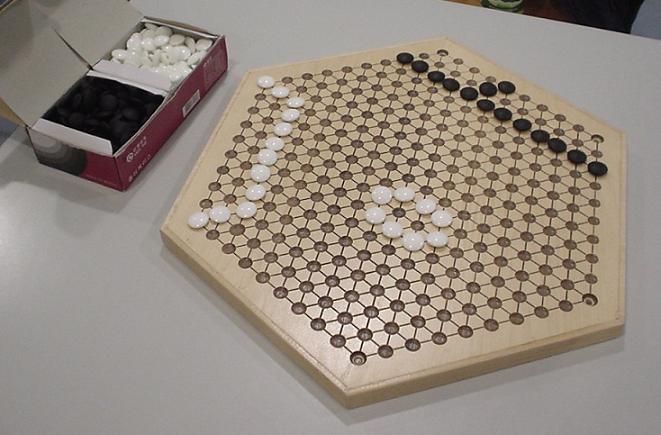Havannah

Havannah,
a two-player zero-sum and perfect information abstract strategy, connection board game played on a base-10 or base-8 hexagonal board, invented in 1979 by Christian Freeling. The pattern of cells are filled with stones one by one. To win, one has to be the first to connect three sides ("fork") or two corners ("bridge") or to form a ring. Computer Havannah is played at the Computer Olympiad organized by the ICGA since 2009 [2]. Most competitive Programs apply variants of Monte-Carlo Tree Search and UCT.
Contents
Computer Olympiads
- 14th Computer Olympiad, Pamplona 2009
- 15th Computer Olympiad, Kanazawa 2010
- 16th Computer Olympiad, Tilburg 2011
Base-10 Board
Base-10 Board by Ed van Zon, demonstrating bridge, ring and fork [3]
The Havannah Challenge
In the Fall/Winter 2002 edition of the "Abstract Games" magazine, Christian Freeling claimed in an open letter that Havannah is too difficult for computers, and that within 10 years no program would be able to achieve a single win against him in a match over ten games - on a base-10 baord, and wagered a €1000 prize money. The challenge match was held October 15–19, 2012 in Enschede, the Netherlands at the offices of DGT over the internet using the igGameCenter [4] [5], during which Freeling played ten games against three of the strongest Havannah-playing programs available, Lajkonik by Marcin Ciura et al., Castro by Timo Ewalds, and Wanderer by Richard Lorentz et al., playing (at least) one game as Black and one as White against each opponent. The match ended in a 7-3 score for humanity, but not 10-0, and Freeling already lost the challenge at game 2, when he had to resign a game with white against Lajkonik. In the first game, its parameters selected by Rémi Coulom's CLOP in quick games versus Castro, Lajkonik played poorly. Marcin used CLOPless values relying on intuition and some test positions for the second game, which Lajkonik won [6].
Publications
2009
- Fabien Teytaud, Olivier Teytaud (2009). Creating an Upper-Confidence-Tree program for Havannah. Advances in Computer Games 12, inria-00380539 as pdf » UCT
2010 ...
- Richard J. Lorentz (2010). Improving Monte-Carlo Tree Search in Havannah. CG 2010
- Richard J. Lorentz (2010). Castro wins Havannah Tournament. ICGA Journal, Vol. 33, No. 4 » 15th Computer Olympiad
- Richard J. Lorentz (2011). Experiments with Monte-Carlo Tree Search in the Game of Havannah. ICGA Journal, Vol. 34, No. 3
- Jan Stankiewicz, Mark Winands, Jos Uiterwijk (2011). Monte-Carlo Tree Search Enhancements for Havannah. Advances in Computer Games 13
- Junichi Hashimoto, Akihiro Kishimoto, Kazuki Yoshizoe, Kokolo Ikeda (2011). Accelerated UCT and Its Application to Two-Player Games. Advances in Computer Games 13
- Richard J. Lorentz (2012). Castro wins Havannah Tournament. ICGA Journal, Vol. 35, No. 1 » 16th Computer Olympiad
- Ingo Althöfer (2012). Havannah – The Old Man and the C’s. ICGA Journal, Vol. 35, No. 4
- Jan Krabbenbos, Ton van der Valk (2012). The Havannah Challenge. ICGA Journal, Vol. 35, No. 4
- Edouard Bonnet, Florian Jamain, Abdallah Saffidine (2013). Havannah and TwixT are PSPACE-complete. CG 2013 [7]
2015 ...
- Joris Duguépéroux, Ahmad Mazyad, Fabien Teytaud, Julien Dehos (2016). Pruning playouts in Monte-Carlo Tree Search for the game of Havannah. CG 2016
External Links
- Havannah from Wikipedia
- Havannah (ICGA Tournaments)
- Havannah from MindSports
- Havannah | Board Game | BoardGameGeek
- Sensei's Library: Havannah
- Lange Nacht der Wissenschaften - Long Night of Sciences, Jena - 2009, Ingo Althöfer's Pictorial report covers Havannah
- Havannah Challenge 2012 games
- Ton van der Valk - YouTube
References
- ↑ Three ways to win in Havannah, Vectorized by Mysid in Inkscape on a PNG by Fritzlein, August 14, 2007, Havannah from Wikipedia
- ↑ Havannah (ICGA Tournaments)
- ↑ Lange Nacht der Wissenschaften - Long Night of Sciences, Jena - 2009, Ingo Althöfer's Pictorial report
- ↑ gGameCenter :: Online games for iGoogle and Facebook
- ↑ Jan Krabbenbos, Ton van der Valk (2012). The Havannah Challenge. ICGA Journal, Vol. 35, No. 4
- ↑ Ingo Althöfer (2012). Havannah – The Old Man and the C’s. ICGA Journal, Vol. 35, No. 4
- ↑ PSPACE-complete from Wikipedia
